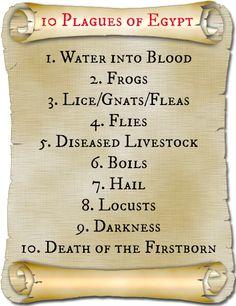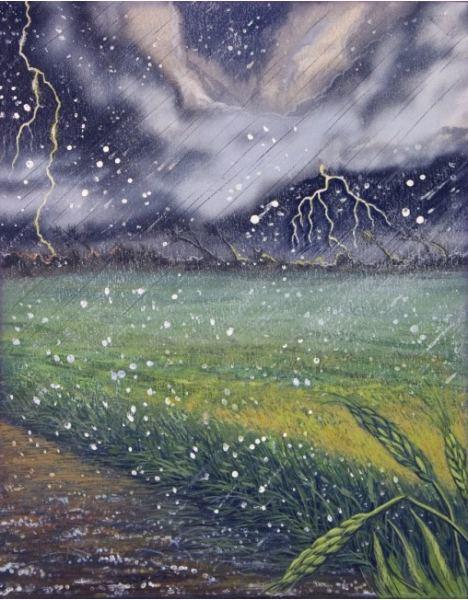Plagues Against the Gods of Egypt
The purpose of the ten plagues in the Book of Exodus is to make known that Israel’s God is the True God and reigns over all people. The ten plagues are a direct attack against the Egyptian gods.
Also, when Moses and Aaron went into Pharaoh’s court at the start of God’s signs and wonders in the land of Egypt, Aaron was commanded by God to throw down his rod and it became a Tanin (type of crocodile). (Exodus7).
The magicians of Egypt could also do the same, but Aaron’s Tanin ate all of theirs. This was probably against the Egyptian god of power, protection and fertility – Sobek, was a god of the Nile (which was believed to have come from his sweat) who gave life to vegetation and fertility to the land.
The ‘Lord of the Waters’ was believed to have risen from the primeval waters of Nun to create the world. As a creator god, he was occasionally linked with the sun god Ra.
One tale says that Sobek laid his eggs on the bank of the waters, starting the creation process. He was thus a fertility god, ‘He Who Made the Herbage Green’. This explains his link to the rebirth of the deceased into the afterlife.
Having the form of a crocodile, the Egyptians believed that he also had the nature of a crocodile. He could be the strong, powerful symbol of the pharaoh, showing the ruler’s might.
He could use this force to protect the justified dead in their after life, and be the protector and rescuer of the other gods… yet he could also use that power to savage his enemies and the sinful deceased.
He could bestow sight and senses to the dead, he could bring water and fertility to the land.
Yet he was also closely linked to the enemy of Osiris. He was a god that was both feared and respected by the ancient Egyptians.
Water turning into blood (Exodus7)
As Aaron, the spokesman for Moses, touched the “rod” of the Lord to the Nile River it immediately turned to blood, all the fish died, and the river stank. The magicians of Egypt could also do this.
This plague was probably against the Egyptian god of Nile – Hapi, was a deification of the annual flooding (inundation) of the Nile River in Ancient Egyptian religion, which deposited rich silt on its banks, allowing the Egyptians to grow crops. (the water bearer). His name means Running One, probably referring to the current of the Nile.
Some of the titles of Hapi were, Lord of the Fishes and Birds of the Marshes and Lord of the River Bringing Vegetation.
Frogs (Ex.8:1-15)
The frogs came up from the river and were in their houses, in their food, in their clothing, in every place possible. The magicians of Egypt could also do this. Pharaoh asked Moses to ask the LORD to remove them. All the frogs died and again the land stank.
This plague was probably against the Egyptian goddess of fertility – Heket who had the head of a frog. It was said that it was Heqet who breathed life into the new body of Horus at birth, as she was the goddess of the last moments of birth. As the birth of Horus became more intimately associated with the resurrection of Osiris, so Heqet’s role became one more closely associated with resurrection.
Eventually, this association led to her amulets gaining the phrase I am the resurrection. She was thought to be the wife of Khnum, the god who created men on his potter’s wheel, and she gave the newly created being the breath of life before the child was placed to grow in the mother’s womb.
She was also regarded as the wife of Horus the Elder in the myths of Osiris – she was represented at the funeral as a frog, symbolic of life and fertility after death.
Gnats (Ex.8:16-19)
At the command of the Lord to Moses, Aaron was told to stretch forth his rod and smite the dust of the earth. When he did the dust became lice throughout all the land, on both people and beasts.
The magicians of Egypt could not do this and said it was the finger of God. This plague was probably against the Egyptian god of the earth – Geb who was over the dust of the earth.
It was believed in ancient Egypt that Geb’s laughter were earthquakes and that he allowed crops to grow. Frequently described mythologically as father of snakes (one of the names for snake was ‘son of the earth’).
Geb could also be regarded as personified fertile earth and barren desert, the latter containing the dead or setting them free from their tombs, metaphorically described as ‘Geb opening his jaws’, or imprisoning those there not worthy to go to the fertile North-Eastern heavenly Field of Reeds.
In the latter case, one of his otherworldly attributes was an ominous jackal-headed stave rising from the ground unto which enemies could be bound.
Flies (Ex.8:20-32)
The Egyptians were plagued by the flies. This plague was probably against the Egyptian god of creation – Khepri who had the head of a fly.
Khepri was connected with the scarab beetle (kheprer), because the scarab rolls balls of dung across the ground, an act that the Egyptians saw as a symbol of the forces that move the sun across the sky.
Khepri was thus a solar deity. (he was was largely subordinate to the greater sun god Ra. Often, Khepri and another solar deity, Atum, were seen as aspects of Ra: Khepri was the morning sun, Ra was the midday sun, and Atum was the sun in the evening).
Young dung beetles, having been laid as eggs within the dung ball, emerge from it fully formed. Therefore, Khepri also represented creation and rebirth, and he was specifically connected with the rising sun and the mythical creation of the world.
The Egyptian connected his name with the Egyptian language verb kheper, meaning “develop” or “come into being”.
Death of Livestock (Ex.9:1-7)
This plague affected the Egyptian by creating a huge economic disaster, in areas of food, transportation, military supplies, farming, and economic goods that were produced by these livestock. This plague was probably against the Egyptian goddess – Hathor who had the head of a cow. Hathor is commonly depicted as a cow goddess with head horns in which is set a sun disk with Uraeus, that suggests a role as sky-goddess and a relationship to Horus who, as a sun god, is “housed” in her.
She was originally a personification of the Milky Way, which was considered to be the milk that flowed from the udders of a heavenly cow. She is an ancient Egyptian goddess who personified the principles of joy, feminine love, and motherhood.
She was one of the most important and popular deities throughout the history of ancient Egypt. Hathor was worshiped by Royalty and common people alike in whose tombs she is depicted as “Mistress of the West” welcoming the dead into the next life.
In other roles she was a goddess of music, dance, foreign lands and fertility who helped women in childbirth, as well as the patron goddess of miners.
Boils and Sores (Ex.9:8-12)
The people and animals were affected by boils. This plague was probably against the Egyptian goddess of Medicine – Isis taught her people the skills of reading and agriculture and was worshipped as the goddess of medicine and wisdom.
Isis was called the Mother of Life, but she was also known as the Crone of Death. Isis was a great enchantress, the goddess of magic. Together with Thoth, she taught mankind the secrets of medicine.
She was the embalmer and guardian of Osiris. She is often rendered on the foot of coffins with long wings spread to protect the deceased.
Hail (Ex.9:13-35)
Hail rained down from the sky and destroyed the crops. This plague was probably against the Egyptian goddess of sky – Nut.
She was originally the goddess of the nighttime sky, but eventually became referred to as simply the sky goddess. Her headdress was the hieroglyphic of part of her name, a pot, which may also symbolize the uterus.
Mostly depicted in nude human form, Nut was also sometimes depicted in the form of a cow whose great body formed the sky and heavens, a sycamore tree, or as a giant sow, suckling many piglets (representing the stars).
Like Hathor she not only had death and rebirth associations, but was the protector of children and the goddess of childbirth. Nut was the goddess of the sky and all heavenly bodies, a symbol of protecting the dead when they enter the after life.
According to the Egyptians, during the day, the heavenly bodies—such as the sun and moon—would make their way across her body. Then, at dusk, they would be swallowed, pass through her belly during the night, and be reborn at dawn.
Locusts (Ex.10:1-20)
Whatever crops were left in tact after the destruction by Hail, were now completely consumed by the swarms of locusts that were unleashed from the sky.
This plague was probably against the Egyptian god of storms and disorder – Seth was a god of the desert, storms, and foreigners in ancient Egyptian religion.
In later myths he is also the god of darkness, and chaos.
Darkness (Ex.10:21-29)
Darkness fell upon Egypt. This plague was probably against the Egyptian sun god – Ra, the ancient Egyptian sun god, identified primarily with the midday sun.
To the Egyptians, the sun represented light, warmth, and growth. This made the sun deity very important as the sun was seen as the ruler of all that he created. The sun disk was either seen as the body or eye of Ra.
The meaning of the name is uncertain, but it is thought that if not a word for ‘sun’ it may be a variant of or linked to words meaning ‘creative power’ and ‘creator’. All forms of life were believed to have been created by Ra, who called each of them into existence by speaking their secret names.
Alternatively humans were created from Ra’s tears and sweat, hence the Egyptians call themselves the “Cattle of Ra.”
Death of the Firstborn (Ex.11:1-10)
Pharaoh the King of Egypt was considered to be the greatest Egyptian god of all. Formal religious practice centered on the pharaoh, the king of Egypt.
Although he was a human, the pharaoh was believed to be descended from the gods. He acted as the intermediary between his people and the gods, and was obligated to sustain the gods through rituals and offerings so that they could maintain order in the universe












